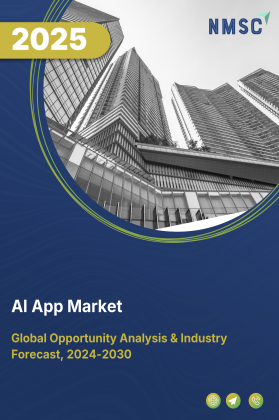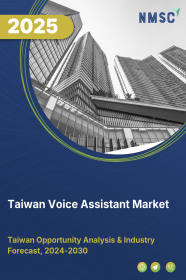
India Voice Assistant Market by Offering (Hardware, Software, and Service), by Technology (Speech Processing, Understanding, and Security), by Application (Consumer, and Enterprise), by End-User (Consumer, Enterprise Verticals, – Country Opportunity Analysis and Industry Forecast, 2025–2030.
Industry: ICT & Media | Publish Date: 08-Oct-2025 | No of Pages: 83 | No. of Tables: 131 | No. of Figures: 76 | Format: PDF | Report Code : IC3375
Industry Overview
The India Voice Assistant Market size was valued at USD 153.01 million in 2024, and is predicted to reach USD 957.61 million by 2030, at a CAGR of 35.7% from 2025 to 2030. The rising smartphone penetration and continuous technological innovation are driving the growing adoption of voice assistants in India by enhancing convenience and hands-free user experiences.
Nonetheless, low digital literacy in India holds back the development of the virtual assistant market by restricting the capacity of users, particularly those in rural and semi-urban regions. On the other hand, with the inclusion of hyper-personalized services in voice interactive systems create future growth opportunities for the industry.
Telecom Sector’s AI-Driven Transformation Accelerates Voice Assistant Demand
India’s telecom sector is witnessing a rapid shift toward AI and automation across customer-facing and network operations. Major operators are integrating voicebots and conversational AI assistants into their support platforms to resolve user queries, personalize recommendations, and boost customer experience—making voice interfaces a core element of telecom services. Government-led programs like the Telecommunications Act and the National Broadband Mission are accelerating broadband access and AI readiness, enabling rollout of voice-based digital services even in semi‑urban and rural pockets. Partnerships between telecom giants and AI developers are further driving the integration of voice capabilities into mobile, broadband, and home service offerings.
Expansion of Smart Home Ecosystem and Multilingual AI Drives Voice Assistant Uptake
The proliferation of smart homes in India is propelling demand for voice control systems that manage lighting, security, entertainment, and energy systems—all accessible via voice commands. Integration with diverse devices—from smart speakers to connected appliances—is creating seamless voice‑enabled home environments, especially as affordability and interoperability improve. Complementing this is the rise of multilingual conversational AI platforms—developed by both global and domestic players—that support Indian languages natively. This makes voice assistants more relevant and inclusive across urban and vernacular user bases, accelerating adoption across households nationwide.
Government Push for Indigenous Language AI and Digital Inclusion Boosts Voice Assistant Penetration
The Indian government’s focus on creating AI tools in native languages is significantly enhancing the accessibility and adoption of voice assistants across the country. Under initiatives like the IndiaAI Mission and Bhashini, efforts are underway to develop speech recognition and synthesis technologies in all 22 scheduled Indian languages. These advancements enable voice assistants to serve users in rural and semi-urban regions more effectively, bridging linguistic and digital divides. Additionally, the expansion of voice-based e-governance services is encouraging public familiarity and trust in voice interfaces, opening up large-scale applications across sectors such as agriculture, healthcare, and education.
Lack of Comprehensive Data Protection Law and Ambiguity Around Voice Data Usage Restrains Market Expansion
In India, the absence of a fully implemented and enforceable personal data protection framework creates uncertainty around the collection, storage, and usage of voice data. While the Digital Personal Data Protection Act (DPDPA) was enacted in 2023, its full operational rollout and enforcement mechanisms are still evolving, leaving voice assistant providers in a grey regulatory zone. This ambiguity discourages innovation, especially in sensitive sectors like healthcare, banking, and education where voice data may contain confidential user information. Moreover, the lack of explicit guidelines on consent, data retention, and cross-border transfers increases legal risk and limits the adoption of voice assistant technologies among privacy-conscious users and enterprises. As a result, both global and domestic companies remain cautious in expanding voice-driven services at scale, delaying market penetration in high-potential segments.
Emergence of Voice-Enabled Vernacular AI Platforms Opens Untapped Regional Market Potential
The rise of voice-enabled AI platforms capable of understanding and interacting in India’s diverse regional languages presents a transformative opportunity for the voice assistant market. With over 70% of India’s population speaking non-English languages, the demand for intuitive, multilingual voice interfaces is accelerating. Recent government-backed initiatives like Bhashini, along with private sector innovation from companies such as Sarvam AI and Ola’s Krutrim, are enabling voice assistants to comprehend and respond in multiple Indian languages and dialects with high accuracy. These systems are being deployed in sectors such as agriculture, public services, and vernacular commerce, offering first-time digital users an accessible and frictionless experience.
For instance, voice assistants that support regional commands can help farmers access weather updates or government schemes in their native language, or enable rural consumers to engage in e-commerce through conversational voice interfaces. As vernacular voice AI continues to mature, it unlocks massive growth potential across Tier 2, Tier 3 cities, and rural India—segments that remain underpenetrated in the current digital ecosystem. This linguistic inclusivity not only expands the user base but also strengthens engagement and trust, positioning voice technology as a cornerstone of India’s inclusive digital future.
Competitive Landscape
The promising players operating in the India voice assistant industry includes Amazon India Pvt. Ltd., Google India Pvt. Ltd., Samsung India Electronics Pvt. Ltd., Apple India Pvt. Ltd., Microsoft India Pvt. Ltd., IBM India Pvt. Ltd., Oracle India Pvt. Ltd., SAP Labs India Pvt. Ltd., Tata Elxsi Ltd., Infosys Ltd., Wipro Ltd., Haptik Technologies Pvt. Ltd. (Jio Platforms Ltd), Uniphore Software Systems Pvt. Ltd., Yellow Messenger Pvt. Ltd. (“Yellow.ai”), and Tech Mahindra Ltd.
India Voice Assistant Market Key Segments
By Offering
-
Hardware
-
Smart Speakers
-
Smartphones & Wearables
-
In‑Vehicle Systems
-
Smart TVs & Appliances
-
-
Software
-
Device-Embedded (OEM)
-
Cloud Platforms & APIs
-
Installable SDKs/Frameworks
-
-
Service
-
Professional Services
-
Managed/Hosted Services
-
Custom Integration
-
By Technology
-
Speech Processing
-
ASR (Speech-to-Text)
-
TTS (Text-to-Speech)
-
-
Understanding
-
NLU (Intent Recognition)
-
Dialogue Management
-
-
Security
By Application
-
Consumer
-
Personal Assistance
-
Smart Home & IoT Control
-
In‑Car Infotainment & Navigation
-
-
Enterprise
-
Customer Service (incl. Payments)
-
Productivity Tools
-
Operational Automation
-
By End-User
-
Consumer
-
Enterprise Verticals
-
BFSI
-
Retail & E‑commerce
-
Healthcare & Pharma
-
Automotive
-
Telecommunications
-
Travel & Hospitality
-
Public Sector/Education
-
Key Players
-
Amazon India Pvt. Ltd.
-
Google India Pvt. Ltd.
-
Samsung India Electronics Pvt. Ltd.
-
Apple India Pvt. Ltd.
-
Microsoft India Pvt. Ltd.
-
IBM India Pvt. Ltd.
-
Oracle India Pvt. Ltd.
-
SAP Labs India Pvt. Ltd.
-
Tata Elxsi Ltd.
-
Infosys Ltd.
-
Wipro Ltd.
-
Haptik Technologies Pvt. Ltd. (Jio Platforms Ltd)
-
Uniphore Software Systems Pvt. Ltd.
-
Yellow Messenger Pvt. Ltd. (“Yellow.ai”)
-
Tech Mahindra Ltd.
REPORT SCOPE AND SEGMENTATION:
|
Parameters |
Details |
|
Market Size Value in 2024 |
USD 153.01 million |
|
Revenue Forecast in 2030 |
USD 957.61 million |
|
Value Growth Rate |
CAGR of 35.7% from 2024 to 2030 |
|
Analysis Period |
2024–2030 |
|
Base Year Considered |
2024 |
|
Forecast Period |
2025–2030 |
|
Market Size Estimation |
Million (USD) |
|
Growth Factors |
|
|
Companies Profiled |
15 |
|
Customization Scope |
Free customization (equivalent up to 80 working hours of analysts) after purchase. Addition or alteration to country, regional, and segment scope. |
|
Pricing and Purchase Options |
Avail customized purchase options to meet your exact research needs. |

















 Speak to Our Analyst
Speak to Our Analyst

























